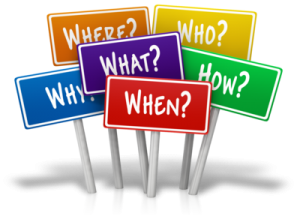Change Communication – High Gain Questions That Get The Attention Of Leaders

The questions we ask when called in to develop a change communication strategy will always produce different outcomes. This article explores that difference between high gain questions and the typical questions we ask and the impact they have on developing a change communication strategy. Imagine a senior executive from a business unit contacts you. His area is embarking on the implementation of a new IT system and you have been asked to prepare the communication strategy.
There are two ways you can go with this. The first is to as the typical internal communication questions.
When is the new system being launched?
Who are the impacted audiences?
What are the significant changes?
Where can employees find training support?
Who are the specific stakeholders and how will each be impacted?
What specific online communication vehicles does your business unit use to communicate with specific stakeholders?
And then you come back with a plan that outlines what will be communicated when, to whom and how. This approach will always facilitate a master – servant relationship, you get called in to produce information on what is changing and provide a service.
High gain questions on the other hand produce a very different change communication approach and can directly impact the business strategy. So here are the types of questions you would ask.
Why are you introducing this system? Now the answer could be because the current system will no longer be supported. That is not the reason. What you want to know is why this system, what will be different, will it provide the organisation with any new types of data? How will they use that data? Why is it important? Who else will use that data? Do they understand how to use the data?
Another way to get information about the reason behind the why is to probe the changing environment in which the organisation operates. A good way to do this is to ask what data did you need five years ago, what data do you need today, what data will you need in 5 years time and why. What will have changed? How can staff prepare for that change? What can they do now that is different to the way they do their work so that they can prepare for the way forward?
This provides you now with the framework to design a change communication strategy that will directly help the business get traction with strategy. So you would design a process that requires managers to communicate and have a specific conversation and drive actions locally. They would then be required to measure outcomes and report those activities and outcomes centrally. You would be focused on what employees could do and what process you could put in place to ensure that behaviour changes and drives the strategic outcomes the business is seeking. Bottomline is that when change communication is focused on action oriented techniques it is always measured against what the business targets are.
Then around this you would build information that specifically addresses improvements, achievements, team successes, measures, impact on the business. And you would have a role for managers at all levels to drive the outcomes and discuss at their meetings. This could be leading process improvements, innovation, identifying new markets, products, ways to improve the customer experience. They will be seeking to identify the improvements and processes that will drive business outcomes and traction with strategy.
Change communication is about energising the organisation to be innovative and at all levels to become engaged. This is so much more powerful that information about system implementation. And yes of course you need the information about the what, when, when and how of the system implementation.
Always ask high gain questions of your clients and you will see the paradigm shift in how they value internal communication. You want a partner relationship versus a master servant relationship that is service oriented. Focusing on high gain questions and designing a change communication strategy instead of an information strategy about change will ensure you get a seat at the table and will make your work so much more rewarding.